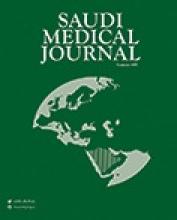To the Editor
I have read with interest the study by Al-Agha et al1 on the diverse etiology of hyperlipidemia among hospitalized children in Western region of Kingdom of Saudi Arabia (KSA). In the descending order of frequency, the authors mentioned that those who have shown to have hyperlipidemia with nephrotic syndrome were 35.6%, primary/idiopathic hyperlipidemia 19.4%, diabetes mellitus (DM) 17.8%, hypothyroidism 7.1%, obesity 4.3%, metabolic syndrome (MS) 2.8%, chronic liver disease 2%, and chronic renal failure 1.2%.1 I presume that the actual prevalence of MS-associated hyperlipidemia in the study was underestimated. My assumption is based on the following 2 points.
First, it is obvious that pediatric MS encompasses a constellation of cardiovascular risk factors, notably dyslipidemia, DM, obesity, and hypertension. The prevalence of the latter 3 elements of MS have been substantially reported in KSA over the recent years. The overall prevalence of DM among children and adolescents has been estimated to be 10.9%, of which 0.5% were known type 1 and type 2 patients with DM and 10.4% were either newly identified cases of DM (4.3%) or impaired fasting glucose (6.1%) with more than 90% of the diabetic patients being unaware of their disease.2 The prevalence of childhood obesity has increased in particular age groups (13-15 years) during a 5-year span from 12.6 [(95% confidence interval) 11.3-13.9] in 2008 to 15.3 [(95% confidence interval) 13.7-16.9] in 2013 (p=0.012).3 Hypertension has been importantly documented in 17.2% of healthy intermediate school children aged 11-18 years.4
Second, there are significant differences in the definition criteria for pediatric MS. Some of these definitions include hyperglycemia after an oral glucose load, while others only consider fasting glycemia; other differences include obesity criteria with different cutoffs for waist circumference or body mass index; different values for dyslipidemia criteria for triglyceride and high density lipoprotein-cholesterol; and different cutoffs for defining hypertension. The approach to each definition differs from the importance that each component or risk factor assumes.5 The use of different MS criteria makes it difficult to know the exact prevalence of MS in a particular pediatric population. This is obvious on noticing that the prevalence of pediatric MS in KSA has been estimated to range from 2-18% according to the sensitivity of the 6 different MS definitions.6 It was not obvious which MS definition was employed in Al-Agha et al’s study.1
Reply from the Author
Abdulmoein E. Al-Agha
Department of Pediatric Endocrinology, King Abdulaziz University Hospital, Jeddah, Kingdom of Saudi Arabia
Thank you for your interest in our study. The percentage of patients with hyperlipidemia in our study per disease is not meant to reflect which disease had hyperlipidemia and which disease did not. It was meant to reflect the various diagnosis of patients who had hyperlipidemia and were following up in our clinic. Meaning that of the 253 children with hyperlipidemia following up at our clinic 2.8% have been diagnosed as metabolic syndrome (MS).
Our paragraph on definition has stated the following regarding the diagnosis of MS, “metabolic syndrome was diagnosed by the presence of 2 or more of the following: insulin resistance and impaired glucose tolerance, elevated total cholesterol and triglyceride concentrations, low circulating high density lipoprotein-cholesterol concentrations, abdominal obesity and high blood pressure.”
Supplements
* Supplements will be considered for work including proceedings of conferences or subject matter covering an important topic
* Material can be in the form of original work or abstracts.
* Material in supplements will be for the purpose of teaching rather than research.
* The Guest Editor will ensure that the financial cost of production of the supplement is covered.
* Supplements will be distributed with the regular issue of the journal but further copies can be ordered upon request.
* Material will be made available on Saudi Medical Journal website.
- Copyright: © Saudi Medical Journal
This is an open-access article distributed under the terms of the Creative Commons Attribution-Noncommercial-Share Alike 3.0 Unported, which permits unrestricted use, distribution, and reproduction in any medium, provided the original work is properly cited.






